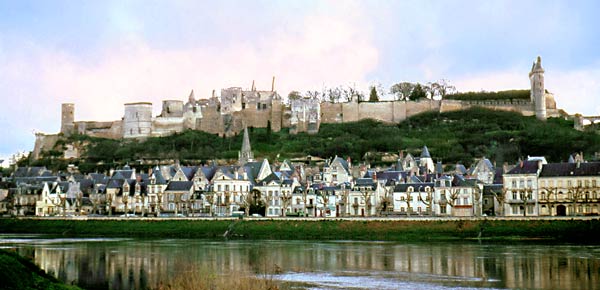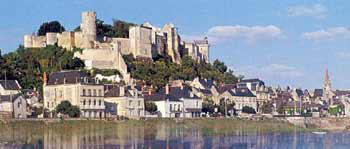Chinon
Chinon is a French town with 7911 inhabitants (as of January 1, 2011 ) in the Indre- et- Loire in the Centre region and sub-prefecture of the arrondissement of Chinon. The site extends over both the banks of the Vienne, close to the inflow into the Loire.
The city is known for the imposing ruins of the castle of Chinon and the Chinon nuclear power plant with four active pressurized water reactors and three disused Magnoxreaktoren.
- 4.1 Chinon wine region
History
The strategically interesting site was already inhabited in the Neolithic period. On a Gallic oppidum was followed by a Gallo- Roman castrum. One of the first major Christian who worked in Chinon, Brictius were of Tours (French Brice to 370-444 ), a follower of Martin of Tours, who founded the Church of St. Martin and Mexme, founder of a church and a monastery. First mentioned in writing was the place as Caino in the 6th century by Gregory of Tours ( 538-529 ). From 964-1044 Chinon came to the counts of Blois. The builder of the first castle was Theobald I of Blois († 975 ). His descendant Theobald III. gave the fief in 1044 the Count of Anjou Gottfried II (French Geoffroi or Geoffroy Martel ).
When Henry Plantagenet, Duke of Anjou ( 1151 ), who had married in 1152 Eleanor of Aquitaine, in 1154 ascended the English throne, Chinon fell under the domination of the English. Henry chose quinone as the residence and different there too, after he had built large parts of the castle. It extends over 430 meters in length and 85 meters in width, the tower reaches a height of almost 40 meters. According to him the castle of Chinon temporarily by Richard the Lionheart and his brother John Lackland and his wife Isabella of Angoulême was inhabited. In 1205 conquered the King of France Philip II Augustus and brought Chinon in Touraine in the royal domain.
Coat of arms
Blazon: In red with three gold perspective, three-towered, brick castles, with a gate, battlements and two windows on each tower, the larger central tower standing back and considered, and three golden heraldic lilies in alternating order in two rows.
Versions: in addition to the modern perspective shape of the stone castle with determinate and bezinntem main tower and the thoughtless, bezinnten Vortürmen (edge towers ), there is a castle shape with three equal, standing in line, brick thoughtless flagged towers, the middle one with the gate closed and a version with determinate and bezinntem main and bezinnten flank towers, the latter with brick conical bases and a window, the main tower with open gate, chain slots and an open gate.
Attractions
The municipality is part of the Regional Natural Park Loire -Anjou- Touraine.
Building
Among the interesting buildings are to be emphasized:
- Gallo- Roman ruins in Bessé, east of the city
- Ruins of the castle of Chinon, of which offers a beautiful view of the well-preserved city
- Collegiate church ( 10th/11th c.) And the monastery at St. Mexme (now a school)
- Old Town, with houses from the 15th and 16th centuries
- Church of Notre- Dame de Parilly (12th century)
- Church of Saint- Étienne ( 15th century )
- Church of Saint- Maurice (12th - 15th century)
- Tour de l' Horloge ( clock tower ), ( in the core 12th century )
- Tour Argenton (15th century)
Museums
Chinon is home to the following museums:
- Musée du Vieux Chinon
- Musée Jeanne d'Arc in the " Tour de l' Horloge "
- Animé Musée du Vin ( Wine Museum )
- Musée des arts et traditions populaires ( Museum of Popular Arts and Traditions )
- Maison de la Rivière, Quai Pasteur, the history of river navigation on the Loire
Economy
The earlier major quarries are no longer in operation today. Main sources of income are agriculture (cereals), animal husbandry, cultivation of vines and fruit trees, the production of goat cheese and tourism. Furthermore, a sawmill in Chinon is a resident. In the suburbs an industrial zone was established.
Chinon wine region
The wines produced here are currently among the best in the whole of France. Above the banks of the Vienne and open for tours, lie the wine cellars where quinone famous Cabernet Franc red wines are stored. This " basement " are actually caves that were carved into the porous limestone, in order to extract the stones for the construction of the castle. Especially the higher caves, whose front was a lot of sunlight, were often used as dwellings by you knew the entrance with a wall, doors and windows. In one of these caves, the Musée Ste was. Ragegonde furnished.
The AOC Chinon has over 2,200 hectares and is located in the Touraine region, opposite the wine region Bourgueil ( see also the article Loire ( wine region ) ). The vineyards spread over:
- Sand and gravel soils in the region Veron, former flood plains between the Loire and Vienne. Here grow light wines.
- Limestone and tuff slopes and plateaus adjacent to Cravant- les Coteaux, Sazilly and Beaumont -en- Véron. This is where medium -bodied wines of the highest class with an excellent aging potential. In good vintages, an excellent Chinon store several decades.
In the year 2002 108.609 hectoliters of red wine (or small amounts of rosé) and 1.100 hl white wine made from Chenin Blanc grapes were pressed.
Chinon in the film
Chinon is the scene in two English movies, their location certainly was not the ruins:
- Becket (1963 ) on the play Becket or the Honour of God by Jean Anouilh, screenwriter Edward Anhalt (Oscar 1964), directed by Peter Glenville, with Peter O'Toole ( Henry II of England ), Richard Burton ( Thomas Becket ) and John Gielgud ( Louis VII of France). Locations were the Shepperton Studios (England), Alnwick Castle and Bamburgh Castle.
- The Lion in Winter (1968), writer James Goldman, directed by Anthony Harvey, with Peter O'Toole ( Henry II of England), Katharine Hepburn ( Eleanor of Aquitaine ), Anthony Hopkins ( Richard the Lionheart ), Nigel Terry ( John Lackland ). Locations were the Ardmore Studios (Ireland ), the Abbey Montmajour at Arles and Tarascon Castle.
Twinning
- Hofheim am Taunus, Germany
- Tiverton in England
Chinon, Hofheim and Tiverton form a " city triangle ", that is, they are also connected with each other through partnerships.
Sons and daughters of Chinon
In Chinon were born:
- To 1493: François Rabelais († 1553), writer of the Renaissance









